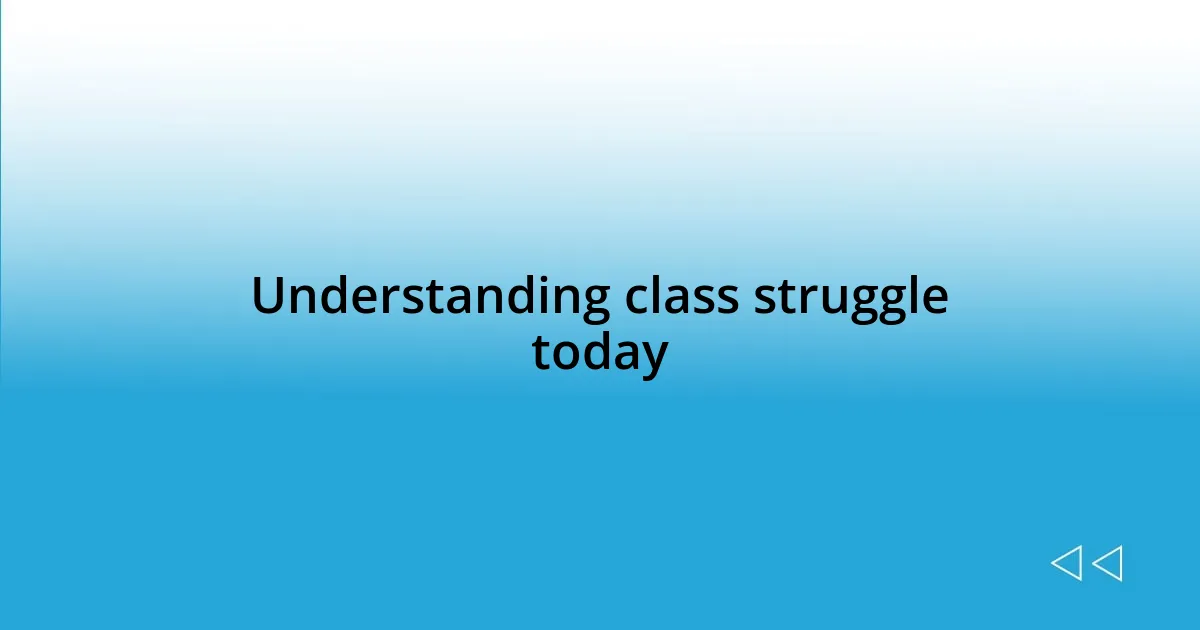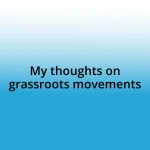Key takeaways:
- Class struggle today is marked by economic inequality, limited access to opportunities, and the impact of digital media on self-perception and mental health.
- The historical context, including events like the Industrial Revolution and the Great Depression, highlights the ongoing fight for workers’ rights and dignity.
- Modern movements leverage social media to amplify marginalized voices, emphasizing intersectionality in struggles, particularly for LGBTQ+ communities.
- Community organizing, education, and advocacy for policy change are crucial strategies for addressing systemic class issues and fostering solidarity.

Understanding class struggle today
Class struggle today often feels like an uphill battle, especially when I reflect on my own experiences. Growing up in a working-class family, I witnessed firsthand the relentless grind to make ends meet. It makes me wonder: How many others silently struggle in the shadows, their voices unheard yet aching to be acknowledged?
On a broader scale, the socioeconomic divide seems to widen every year. Just last week, I spoke to a friend who works multiple jobs yet still finds himself unable to afford basic healthcare. It’s disheartening and raises a critical question: How can we expect progress if so many are trapped in a cycle of poverty with limited access to opportunities?
Moreover, the digital age has transformed how class struggle manifests. Social media platforms, for instance, have become a double-edged sword—providing a voice to the marginalized while simultaneously highlighting the disparities in wealth. I often think about those who scroll through their feeds, comparing their lives to curated images of affluence, and it leads me to ask: How does this constant comparison impact our mental health and our sense of belonging in society?

Historical context of class struggle
The historical context of class struggle reveals deep-rooted issues that have evolved over centuries. For me, understanding this backdrop is crucial. I often think back to the Industrial Revolution, a time when workers faced horrific conditions in factories. It’s a stark reminder of how far we’ve come, yet it raises questions—have we truly left those exploitative practices behind?
When I consider events like the labor movements of the early 20th century, I can’t help but feel a connection to those brave individuals fighting for rights we sometimes take for granted today. I remember volunteering at a food bank and seeing families settle for limited choices because of their economic status. It made me realize that the struggles of yesterday echo in the lives of those who still battle for dignity and respect amidst today’s challenges.
Lastly, the Great Depression also stands as a testament to resilience. The experiences of everyday people during that turmoil feel almost parallel to today’s job uncertainty. I reflect on the stories my grandmother told me about standing in breadlines, and I see parallels with individuals today juggling bills, hoping one day things will change. It’s this legacy of struggle that continues to shape our current societal landscape, pushing us to confront our present issues with awareness and determination.
| Historical Event | Impact on Class Struggle |
|---|---|
| Industrial Revolution | Workers faced brutal conditions, leading to the formation of labor unions. |
| Labor Movements | These movements fought for workers’ rights and fair wages, impacting today’s labor laws. |
| Great Depression | Economic downturn highlighted vulnerabilities, influencing social safety nets and reforms. |

Key factors influencing class struggle
The factors influencing class struggle today are complex and multifaceted. Economic inequality stands at the forefront, with a widening gulf between the rich and the poor. I remember having a chat with a former classmate who’s now a single parent. She juggles two part-time jobs yet often has to choose between paying bills or buying groceries. This reality isn’t just hers; it’s a shared experience that many endure, which underscores the systemic issues fueling class divides.
- Economic Inequality: The gap between the wealthy and the working class is growing, creating barriers to social mobility.
- Job Market Changes: Automation and outsourcing have led to job insecurity, forcing many to work multiple low-wage positions.
- Access to Education: Educational opportunities are often determined by socioeconomic status, perpetuating cycles of poverty.
- Healthcare Disparities: A lack of accessible healthcare has resulted in a workforce that’s physically unable to participate fully in the economy.
- Cultural Narratives: Media representations often glamorize wealth, exuding a sense of failure for those struggling, further entrenching feelings of inadequacy.
I’m constantly reflecting on the role of policy in addressing these struggles. When I advocate for changes aimed at improving workers’ rights, I think about my neighbor, who worked his entire life at a factory and still couldn’t afford a comfortable retirement. It’s not just numbers; it’s real people facing challenges daily. Each time I engage in community discussions about wage increases or fair housing, I feel a spark of hope, knowing that change, though slow, is possible when we come together.

Class struggle in various societies
Class struggles can vary significantly across different societies, but one thread remains constant: the quest for equality and dignity. For example, when I traveled to South America, I was struck by the stark differences between the affluent and the marginalized communities. I can still feel the weight of conversations I had with local activists who passionately spoke about land rights while recounting stories of families evicted from their homes. It made me realize that the fight for basic human rights is not just about survival; it’s about asserting one’s place in society.
In India, I had the opportunity to witness the fight against caste discrimination firsthand. I remember sitting in a community meeting where individuals from lower castes shared their struggles in finding decent work. The determination in their voices resonated with me. They were not just battling economic hardship; they were also confronting deeply ingrained social stigmas that perpetuate class divisions. It raised a question in my mind: How can societies truly progress if segments of their population are still marginalized simply because of their background?
Moreover, class struggle in more developed nations often takes on different forms, such as the fight for fair wages and job security in the gig economy. I was once part of a discussion among young freelancers about how their lack of benefits and job stability felt precarious. One friend recounted a time when he had to forgo needed medical care because he couldn’t afford it without health insurance. This personal narrative highlighted a significant issue: even in rich countries, wealth doesn’t guarantee security, and the struggle continues in various shapes and sizes across the globe.

Modern movements and their impact
Modern movements have reshaped the landscape of class struggle, serving as catalysts for change. Recently, I attended a rally focused on raising the minimum wage, and the atmosphere was electric. Hearing workers share their stories of survival and resilience deeply moved me; it was clear that through collective action, they were not just fighting for better pay but also reclaiming their dignity.
Social media has played an undeniable role in mobilizing voices that were once marginalized. I often scroll through my feeds and see hashtags promoting various causes, from racial justice to climate action. It makes me wonder, how effective are these digital advocacy campaigns in driving real-world change? In my own experience, I’ve connected with like-minded individuals online, leading to local meetups where we strategize and amplify our efforts in our communities. This blend of technology and grassroots activism highlights an exciting shift in how class struggles are addressed today.
Moreover, movements that champion inclusivity are shining a light on intersectionality in class struggle. In discussions with friends who identify as LGBTQ+, they often point out how their sexual orientation adds layers to their economic challenges. This intersectionality makes me think, how can we fully grasp class struggle without understanding the unique experiences of those at the margins? It’s a crucial insight; unless we listen to diverse voices, we risk ignoring the full spectrum of challenges that intertwine with class issues, making our pursuit of justice all the more complex and essential.

Strategies for addressing class struggle
Addressing class struggle requires a multifaceted approach, and one effective strategy I’ve seen is the power of community organizing. I recall volunteering at a local food bank where I met dedicated individuals who created networks facilitating access to resources for marginalized groups. Their commitment to fostering connections among people with shared struggles was not only inspiring, it was transformative. How can we tap into that potential to create solidarity in our own neighborhoods?
Education is another vital tool for tackling class struggle. I once participated in a workshop aimed at financial literacy for underprivileged youth. It was gratifying to witness participants’ expressions change as they grasped basics like budgeting and credit management. The empowerment that comes from understanding financial systems made me realize that when people have the knowledge, they can navigate their circumstances more effectively. Isn’t it fascinating how information can level the playing field?
Finally, advocating for policy change plays a crucial role in addressing systemic issues. I remember engaging in a lively discussion with friends about the need for affordable housing policies in our city. The urgency in their voices echoed the fears shared by many families facing eviction. It struck me that grassroots efforts combined with pressure on lawmakers could lead to tangible change. What steps can we take to hold our representatives accountable? Actively participating in local governance can amplify our collective voice and make a real impact.
















